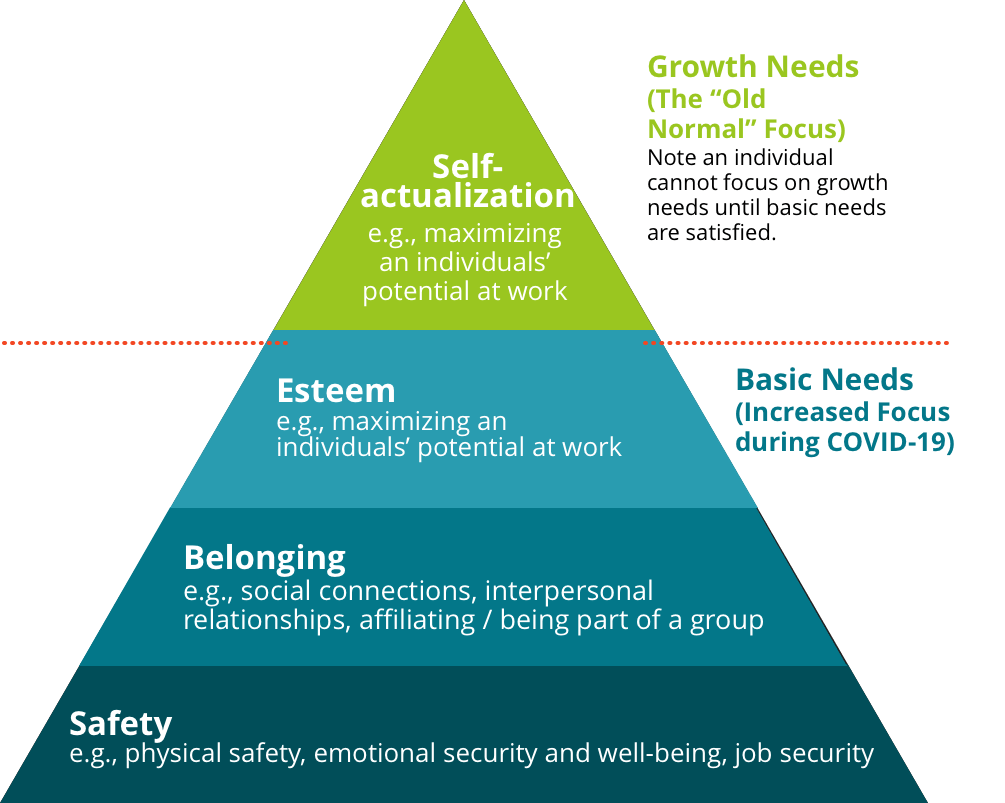Re-shaping your people strategies to drive organizational performance.
As businesses and governments continue to cope with the profound and ongoing impacts of COVID-19, leaders are strategizing on ways to quickly bounce back as economies restart and employees return back to work. But the reality is, the world has changed dramatically and bouncing back isn’t enough. Organizations must bounce forward to meet new realities. Bouncing forward requires not evolving your business strategy for “the new normal”, but re-shaping how to best engage and support employees in achieving it. Employees are the life blood of an organization. But they are not currently set up to thrive—workers are under extreme stress and worried about their health, safety, and job security.
Dig deep to understand and address employee wellbeing
As COVID-19 has unfolded, leaders were thrust into crisis mode, focused on economic realities and how to sustain their business. For many organizations, keeping a pulse of employee sentiment took a backseat.
But it has never been more important to understand employees’ needs and to keep a pulse on their wellbeing—what they are thinking and feeling in this moment. Not only is their physical health top of mind, but also their psychological wellbeing and their ability to feel safe and comfortable in the workplace.
Bouncing forward means understanding and addressing employees’ concerns about their basic needs including personal health, as well as their physical and financial safety. Only then will your employees have the ability to fully engage in helping to drive your “new normal” business strategy forward.
Only 37% of US employees think that their organization has the resilience to withstand this crisis.
Source: Eagle Hill Consulting COVID-19 Employee Confidence Index, June 15, 2020
Employee needs matter
In today’s world, Abraham Maslow’s Theory of Human Motivation is more relevant than ever. In order to bounce forward, leaders should re-examine Maslow’s model and find new meaning in the current context, especially as leaders reshape their people strategies to meet their evolving business priorities.
Maslow believed that each individual has a hierarchy of needs, consisting of physiological, safety, social, esteem, and self-actualization. Maslow’s theory says that humans act to satisfy their unmet needs. If one is hungry, for example, he/she looks for food to satisfy a basic physiological need. Once a need is satisfied, its importance to the individual diminishes, and a higher-level need is likely to motivate the person.
Businesses can drive successful organizational performance by paying close attention to its employees’ human needs at all levels of Maslow’s hierarchy.
Before the pandemic, many employees likely were focused on “growth needs”— performance and career advancement. Now, employees are focused on “deficiency needs”—physical safety and social connections. Employees and businesses cannot arrive at growth needs until these basic needs are met.
To empower employees—and your organization—to bounce forward through unprecedented change, leaders must understand and connect with their people on a entirely new level—so that their basic needs are met and they can rise to self-actualization.
44% of the US workforce says that the #1 thing they want to see in the post-COVID-19 workplace is transparency and open communication from leadership.
Source: 2020 Eagle Hill Consulting COVID-19 Returning to Work Survey
The Eagle Hill Workforce Hierarchy of Needs: Questions for employees
Based on Maslow’s hierarchy of needs, Eagle Hill created a Workforce Hierarchy of Needs to provide a framework for how leaders engage and support employees. Only once leaders understand the extent to which the basic needs of their employees are met, can they understand what gaps exist and make informed decisions about key actions to further engage and empower employees.
Understanding concerns at each level will help you focus in on shoring up any gaps around basic needs so that employees are able to maximize their potential at work and organizations can “bounce forward”.
Workforce Hierarchy of Needs

Source: A.H. Maslow, A Theory of Human Motivation, 1943
Questions leaders need to ask their employees today

Self-actualization
Does your organization welcome your ideas to advance the organization?
What new skills would help you be more successful in the coming year?
Do you feel you are doing meaningful work?

Esteem
Do you feel recognized for a job well done?
Do you feel that you can advance in your job?
Do you feel that your role is important in achieving your organization’s mission?

Belonging
How connected do you feel to your colleagues?
Do you feel that your colleagues have your back?
Do you feel that you can be yourself at work?

Safety
What is your current stress level?
Do you have confidence in the future of this organization?
Do you feel safe being at work?
Do you have confidence that the organization is making the right choices to support you and your team?

